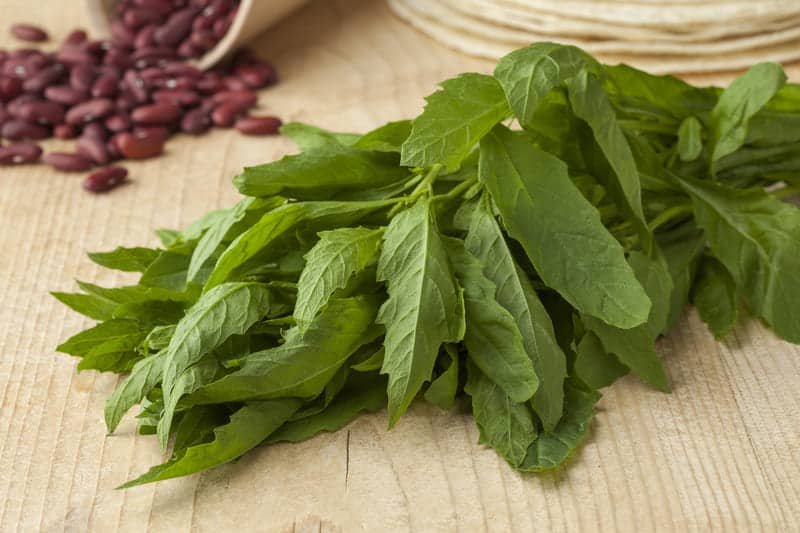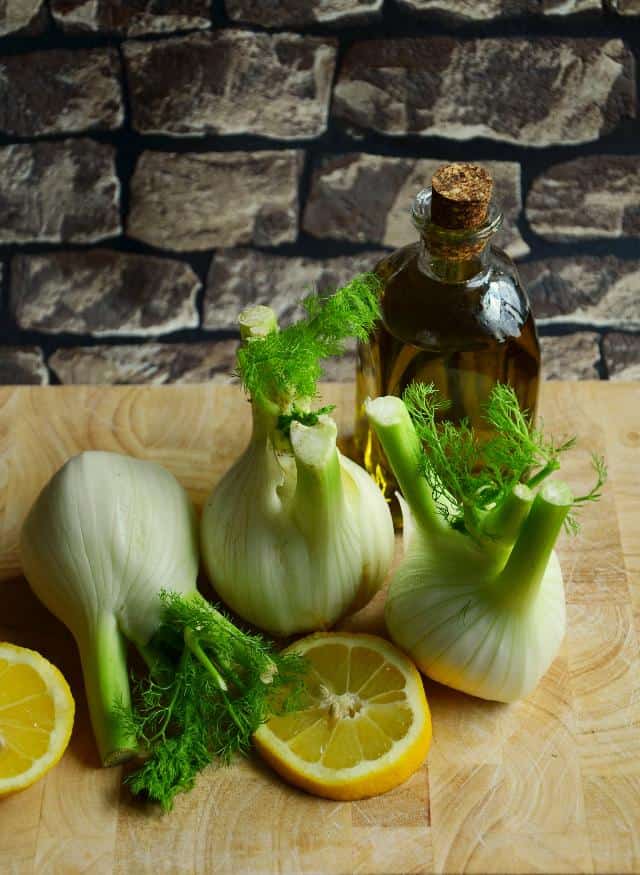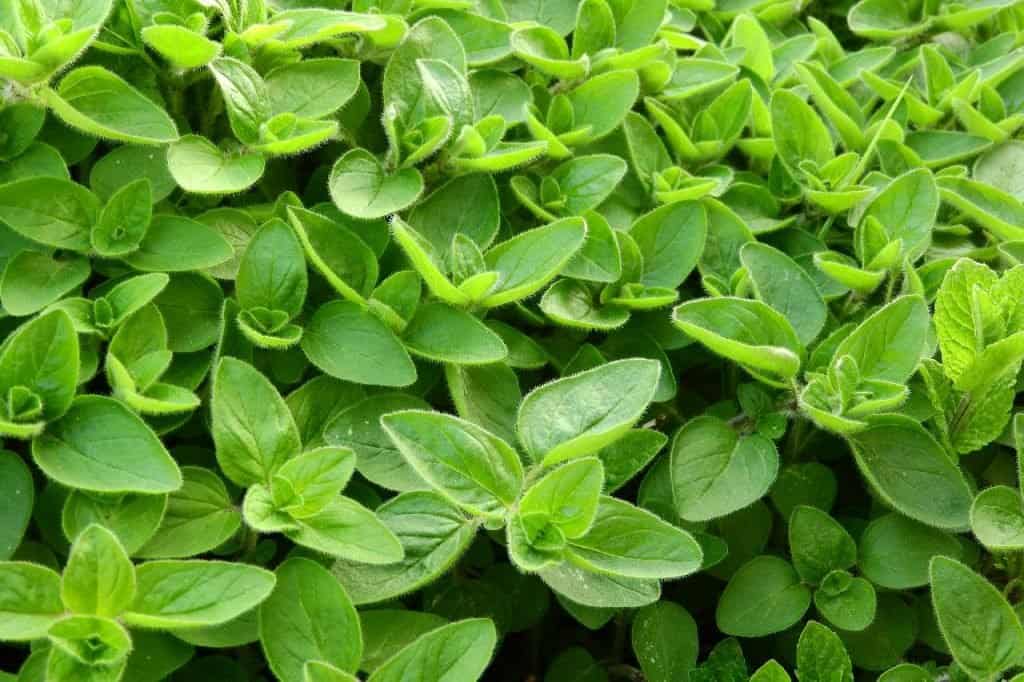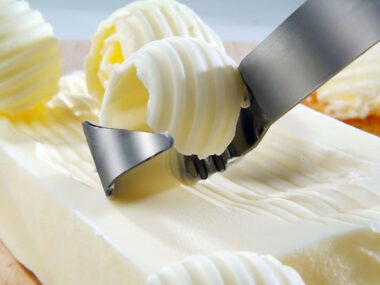Epazote is an aromatic herb native to Southern Mexico, Central and South US. However, you can also find it as a weed in Europe and Asia. It’s also known by other names including pazoli, pizate, pazote, ipasote, apazote, or paico.
In English, it’s called Mexican tea, wormseed, goosefoot, or skunk weed. Epazote is a medicinal herb and an aromatic herb in some cuisines, especially in Mexican.
It has sweet like anise and peppery like oregano flavor with citrus and mint hints and because of its strong flavor, you should use Epazote in small amounts.
This aromatic herb is traditionally used with black beans for flavor and to reduce gas and bloating. Epazote is also common in other traditional Mexican dishes such as soups, chilaquiles, tamales with cheese and chili peppers, enchiladas, fried white rice, and green salsa.
Fresh epazote is better for cooking. However, dried epazote works just as well. It’s easy to grow so you can grow it in your yard. Therefore you will always have fresh epazote. If you are using dried epazote you will have less intense flavor in your dish.
You can buy epazote in Mexican grocery stores fresh in bunches. Store it in a glass of water, or wrap the bunch in wet paper and put them in a plastic bag. If you want to have this herb always on your hand freeze the leaves in an ice cube tray with water, and use as many cubes you need for your dish.
However, what if you want to use epazote in your cooking but can’t find it in your local grocery store? In this case, cilantro, papalo leaves, parsley, oregano, fennel, or some of the following substitutes can save your dish.
Epazote Substitutes
Epazote has a very unique flavor that can’t be easily reached. But you can try and use some of the following substitutes if you don’t have epazote on hand.
1. Cilantro
Cilantro is the leaves of the coriander plant. It’s also known as Mexican parsley or Chinese parsley. The seeds of the coriander plant make a good spice. Cilantro is common in many Asian, Indian, Mexican, and Middle Eastern recipes.
It has a spicy flavor with a hint of citrus. You can use it fresh and dried, however, if you use fresh cilantro, add it at the end of cooking. It will lose some of the flavors if cooked longer.
Cilantro has a different flavor than epazote. However, it can be a good substitute because they both have the same citrus hint.
2. Papalo
Papalo is a great substitute for cilantro. It tastes similar to cilantro, arugula, and rue. Its leaves should be added at the end of cooking. Otherwise, they will lose their flavor.
This herb is very resistant to heat, and it’s available all summer. It has a stronger taste than cilantro. So, add it in smaller amounts when replacing epazote. Fresh papalo is perfect in salads, quesadillas, and pork sandwiches.
3. Fennel
Fennel is a herb from the carrot family. It’s consists of white bulbs, green stalks and leaves, and seeds. It is used in many cuisines around the world like Italian, Chinese, Spanish, Indian, and other Middle Eastern countries.
Fennel bulbs can be eaten raw, sauteed, grilled, braised, or stewed. The leaves can be used to add flavor to soups, sauces, salads, or as a garnish. Fennel has a refreshing flavor that reminds people of anise and licorice. And it adds crunchiness to the dishes when used raw.
Fennel seeds can be used whole or grounded and added to soups, curries, spice mixtures, meat, vegetables, and bread. Fennel has some health benefits too. It improves digestion, helps to regulate blood pressure, and same as epazote reduces bloating and gas.
4. Summer savor
There are two types of savory. Summer savory and winter savory. Summer savory is with a lighter aroma and a sweeter taste than winter savory. It has a similar flavor to thyme, marjoram, and mint.
Summer savory is perfect for sauces, stews, beans, lentils, as a seasoning for meats, fish, or as a garnish to salads. It is one of the main ingredients for the mixture of spices known as Herbes de Provence.
Winter savory has a stronger and bitter taste. It works well with beans, poultry, soups, and sauces. The best part? It has some health benefits and helps with bloating, diarrhea, sore throat, and cough.
5. Mexican oregano
Mexican oregano is a member of the verbena family that grows in Mexico, Central, and Southwestern America. Regular oregano and Mexican oregano have different flavors. Mexican oregano has a strong grassy flavor with a citrus hint.
It’s used in tacos, stews, chilis, meats, soups, beans, and many other dishes. The Mexican oregano contains vitamins, minerals, antioxidants, which can help with some health issues like diarrhea, colds, stomach pains, and respiratory infections.
6. Italian parsley
Italian parsley is an herb used in many different cuisines in the world. It has green flat leaves and steams. But usually, only leaves are good for cooking. Add them to your dish whole or chopped.
There are many types of parsley. However, Italian parsley and curly parsley are the most common for cooking. Curly parsley works great as a garnish. It has less flavor and a bitter grassy taste.
Italian parsley has a bit peppery flavor with a hint of clove, nutmeg, and citrus. When added to dishes it enhances the flavor of the other ingredients whit its freshness.
Italian parsley is used whole in soups, stocks, and sauces, as a bunch. The leaves are perfect for preparing meatloaf or meatballs or as a garnish in salads.
7. Culantro
Culantro is a local herb from Mexico, Central, and South America, and the Caribbean. It has a similar flavor to cilantro but a different appearance.
Culantro has long green leaves, which should be added while cooking because it has a strong flavor. When they are cooked the flavor is more reduced.
Culantro is used in recipes with beans, rice, vegetables, seafood, and meats. It also helps with health issues like asthma, high blood pressure, flu, colds, upset stomach, and toothaches.
8. Lemon verbena
Lemon verbena is a plant from the verbena family. Its leaves have a strong lemon flavor. They’re perfect for making herbal teas and liqueurs.
Lemon verbena is also great for salad dressings, marinades, soups, jams, puddings, and more. It can replace epazote because they both have similar lemon flavors.
9. Coriander
Coriander comes from the seeds of the coriander plant. The leaves are known as cilantro. It has a floral, lemony flavor. And it works well in different dishes like curries, sauces, soups, salads, marinades for meat and fish, mushrooms, and pickling vegetables.
10. Marjoram
Marjoram is an herb similar to oregano but with a different flavor. It has a sweeter flavor than oregano with pine and citrus hints.
Dried marjoram is perfect for salads, meat dishes, tomato-based dishes, stews, soups, sauces, and herbal teas. You can use it instead of epazote since they both have some citrus hint in their flavor.
FAQs
Is epazote the same as Mexican oregano?
Epazote and Mexican oregano are different herbs with similar citrus flavors. Therefore, they’re the perfect substitute for one another.
What is epazote called in English?
People also call it Mexican tea, wormseed, goosefoot, or skunk weed.
What spice is epazote?
Epazote is a spice with sweet like anise and peppery like oregano flavor with citrus and mint hints.
The Takeaway
Epazote is a staple in traditional herbal medicine. However, it’s also a common spice. It’s toxic if used in high doses. Therefore, always follow your recipe for the right amount.
You can replace dried epazote for fresh with a 1:1 ratio but try to use the fresh herb if you can find it. You can find it in most Mexican stores.
However, if you don’t like its taste or don’t have time to go shopping you can substitute it with some of the herbs mentioned in this article.







